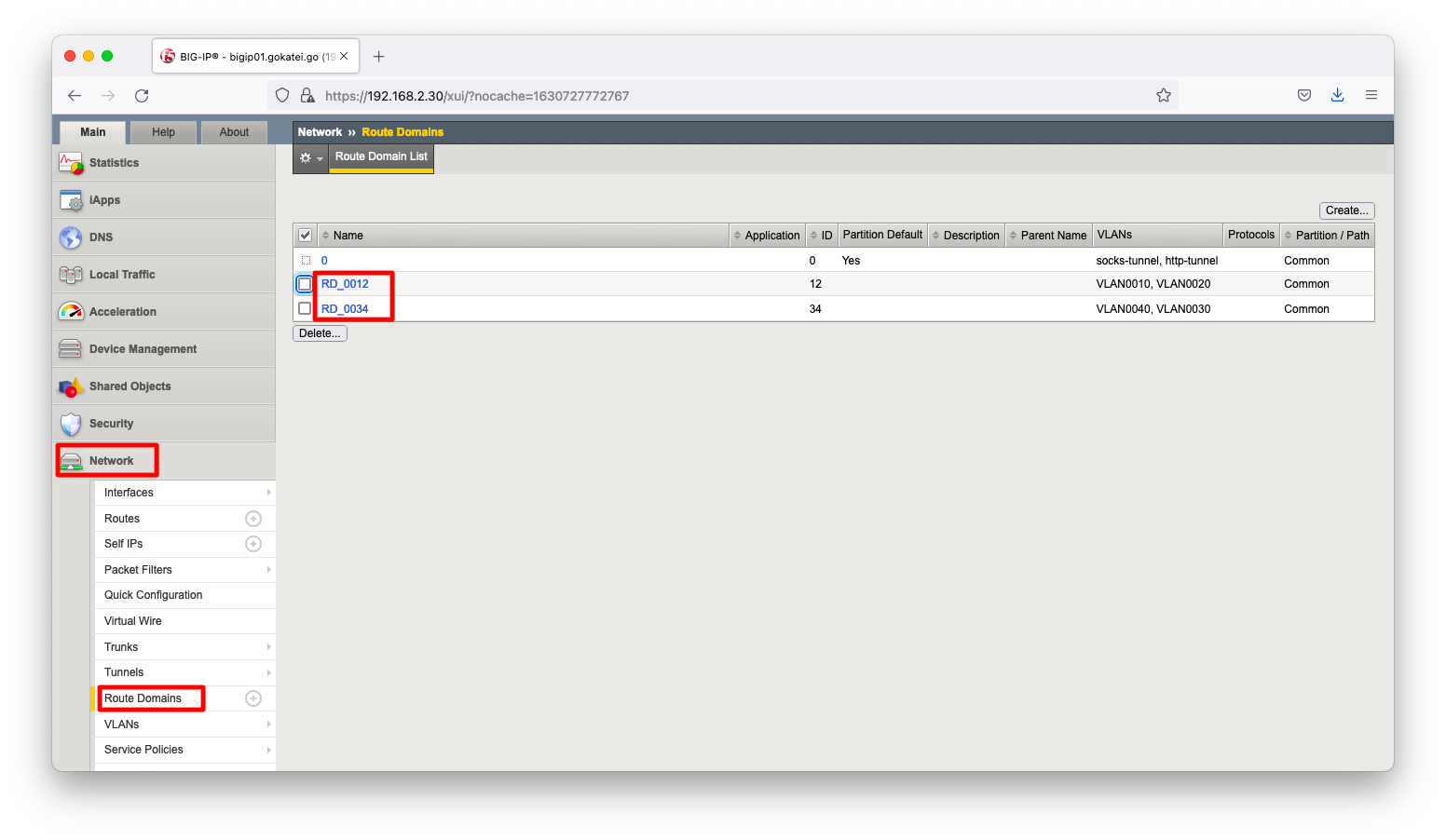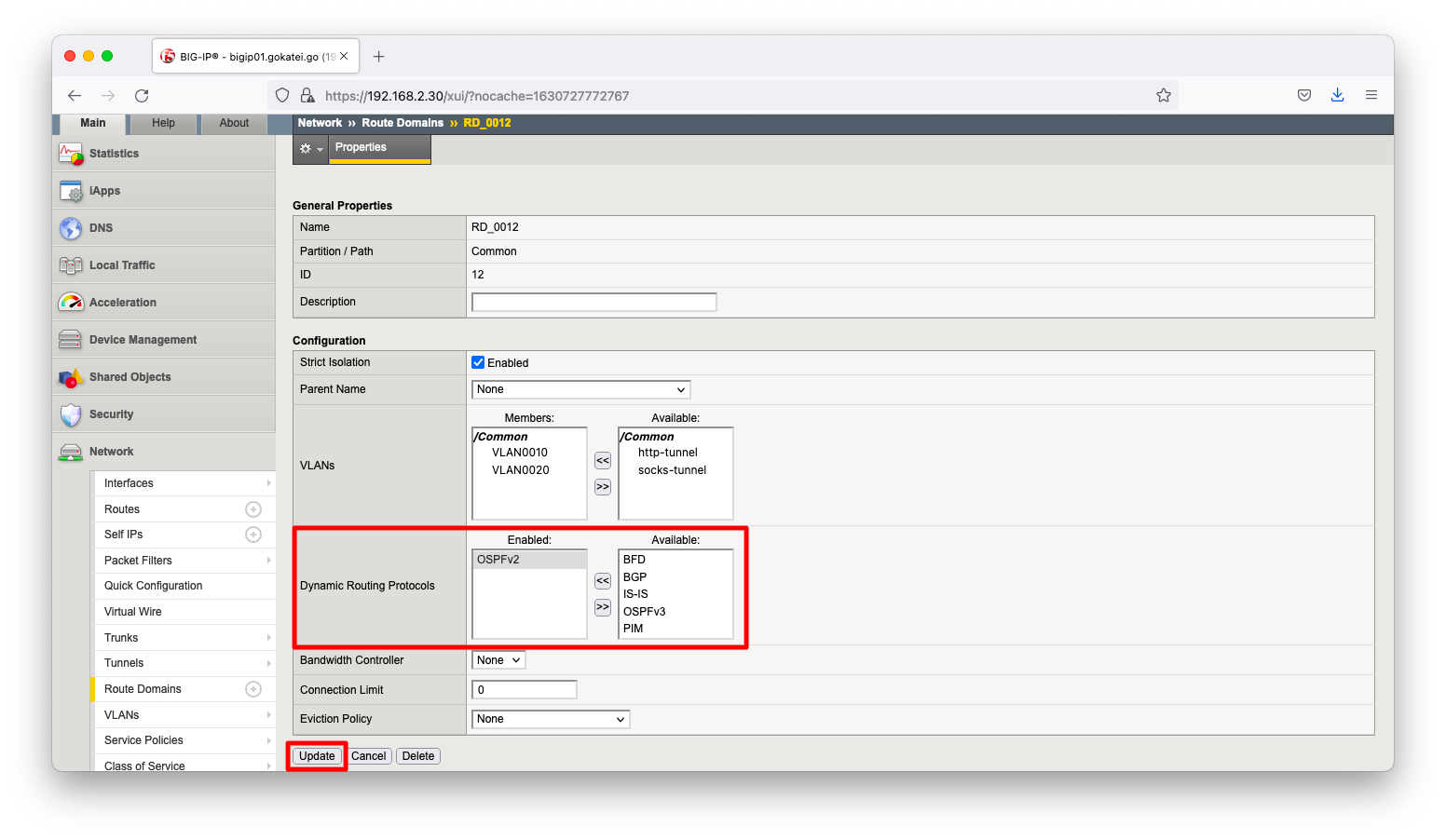BIG-IPでOSPFを設定する方法を説明します。
動作確認の構成
構成図
「BIG-IP パーティションによる分割」の動作確認が終了した時点の構成を用いて動作確認をします。この構成で、Server10とServer30が互いに疎通できる設定を考察します。
+-----------------+
.50 | (Vyatta) | .50
+----------+ Router50 +----------+
| eth0 | | eth1 |
| +-----------------+ |
| |
| 192.168.20.0/24 192.168.40.0/24 |
| (vlan 20) (vlan 40) |
| |
| .1 | .1
+--------+--------+ +--------+--------+
| bigip01 | | bigip01 |
| RouteDomain 12 | | RouteDomain 34 |
| | | |
+--------+--------+ +--------+--------+
| .1 | .1
| |
| 192.168.10.0/24 192.168.30.0/24 |
| (vlan 10) (vlan 30) |
| |
| .10 | .30
+--------+--------+ +--------+--------+
| | | |
| Server10 | | Server30 |
| (RockyLinux84) | | (RockyLinux84) |
+-----------------+ +-----------------+
初期設定
BIG-IPの初期設定は以下の通りとします。Router50にはOSPF設定済とします。
動作確認
ZebOSの起動
BIG-IPはZebOSと呼ばれるソフトウェアを使用してOSPFを実現します。デフォルトの状態ではZebOSは起動していませんので、まずはZebOSを起動します。
「Network」「Route Domains」の順に画面遷移し、「ルートドメイン名」を押下します。

「Dynamic Routing Protocols」欄を設定し、「OSPFv2」を有効にします。

コマンドラインで操作する場合は以下の通りです。
modify net route-domain RD_0012 routing-protocol replace-all-with { OSPFv2 }
modify net route-domain RD_0034 routing-protocol replace-all-with { OSPFv2 }
ZebOSが有効になっているかどうか不安な場合は、以下のようにzebosコマンドを使用すると起動有無を確認できます。
[bigip01:BIG-IP 16.1.0] [root@bigip01:Active:Standalone] config # zebos -a check === route domain: 0 === === route domain: 12 === nsm is running [12705] imi is running [12704] ospfd is running [12706] === route domain: 34 === nsm is running [12756] imi is running [12755] ospfd is running [12757] [root@bigip01:Active:Standalone] config #
OSPFの設定
ZebOSを操作するには、imishと呼ばれるコマンドラインツールを使用します。書式は以下の通りです。
imish -r <RD番号>
操作例は以下の通りです。Cisco IOSとほぼ同等の操作感です。
[root@bigip01:Active:Standalone] config # imish -r 12 bigip01.gokatei.go[12]>en bigip01.gokatei.go[12]#conf t Enter configuration commands, one per line. End with CNTL/Z. bigip01.gokatei.go[12](config)#router ospf 1 bigip01.gokatei.go[12](config-router)# passive-interface VLAN0010 bigip01.gokatei.go[12](config-router)# network 192.168.10.0/24 area 0 bigip01.gokatei.go[12](config-router)# network 192.168.20.0/24 area 0 bigip01.gokatei.go[12](config-router)#end bigip01.gokatei.go[12]#exit [root@bigip01:Active:Standalone] config # [root@bigip01:Active:Standalone] config # [root@bigip01:Active:Standalone] config # imish -r 34 bigip01.gokatei.go[34]>en bigip01.gokatei.go[34]#conf t Enter configuration commands, one per line. End with CNTL/Z. bigip01.gokatei.go[34](config)#router ospf 1 bigip01.gokatei.go[34](config-router)# passive-interface VLAN0030 bigip01.gokatei.go[34](config-router)# network 192.168.30.0/24 area 0 bigip01.gokatei.go[34](config-router)# network 192.168.40.0/24 area 0 bigip01.gokatei.go[34](config-router)#end bigip01.gokatei.go[34]#exit [root@bigip01:Active:Standalone] config #
OSPFの確認
imishコマンドを使用すれば、Cisco IOSのようなOSPFの確認が可能です。
[bigip01:BIG-IP 16.1.0]
[root@bigip01:Active:Standalone] config # imish -r 12
bigip01.gokatei.go[12]>show ip ospf neighbor
OSPF process 1:
Neighbor ID Pri State Dead Time Address Interface
192.168.40.50 1 Full/DR 00:00:34 192.168.20.50 VLAN0020
bigip01.gokatei.go[12]>
bigip01.gokatei.go[12]>
bigip01.gokatei.go[12]>show ip route
Codes: K - kernel, C - connected, S - static, R - RIP, B - BGP
O - OSPF, IA - OSPF inter area
N1 - OSPF NSSA external type 1, N2 - OSPF NSSA external type 2
E1 - OSPF external type 1, E2 - OSPF external type 2
i - IS-IS, L1 - IS-IS level-1, L2 - IS-IS level-2, ia - IS-IS inter area
* - candidate default
C 127.0.0.1/32 is directly connected, lo
C 127.1.1.254/32 is directly connected, tmm
C 192.168.10.0/24 is directly connected, VLAN0010
C 192.168.20.0/24 is directly connected, VLAN0020
O 192.168.30.0/24 [110/21] via 192.168.20.50, VLAN0020, 00:02:43
O 192.168.40.0/24 [110/11] via 192.168.20.50, VLAN0020, 00:02:43
Gateway of last resort is not set
bigip01.gokatei.go[12]>
rdsh入力後に、ip routeコマンド等でも確認可能です。
[bigip01:BIG-IP 16.1.0] [root@bigip01:Active:Standalone] config # rdsh 12 [root@bigip01:Active:Standalone] config # ip route 127.1.1.0/24 dev if3 proto kernel scope link src 127.1.1.254 192.168.10.0/24 dev if5 proto kernel scope link src 192.168.10.1 192.168.20.0/24 dev if7 proto kernel scope link src 192.168.20.1 192.168.30.0/24 via 192.168.20.50 dev if7 proto zebra 192.168.40.0/24 via 192.168.20.50 dev if7 proto zebra [root@bigip01:Active:Standalone] config #
疎通確認
server10からserver30へ疎通可能である事を確認します。
[server10:RockyLinux8.4] [root@server010 ~]# traceroute -n 192.168.30.30 traceroute to 192.168.30.30 (192.168.30.30), 30 hops max, 60 byte packets 1 192.168.10.1 0.952 ms 0.839 ms 0.806 ms 2 192.168.20.50 1.486 ms 1.294 ms 1.239 ms 3 192.168.40.1 1.425 ms 1.307 ms 1.289 ms 4 * * 192.168.30.30 3.867 ms [root@server010 ~]# [root@server010 ~]# [root@server010 ~]# ping -c 3 192.168.30.30 PING 192.168.30.30 (192.168.30.30) 56(84) bytes of data. 64 bytes from 192.168.30.30: icmp_seq=1 ttl=61 time=1.72 ms 64 bytes from 192.168.30.30: icmp_seq=2 ttl=61 time=1.74 ms 64 bytes from 192.168.30.30: icmp_seq=3 ttl=61 time=1.82 ms --- 192.168.30.30 ping statistics --- 3 packets transmitted, 3 received, 0% packet loss, time 2004ms rtt min/avg/max/mdev = 1.720/1.759/1.821/0.044 ms [root@server010 ~]#

